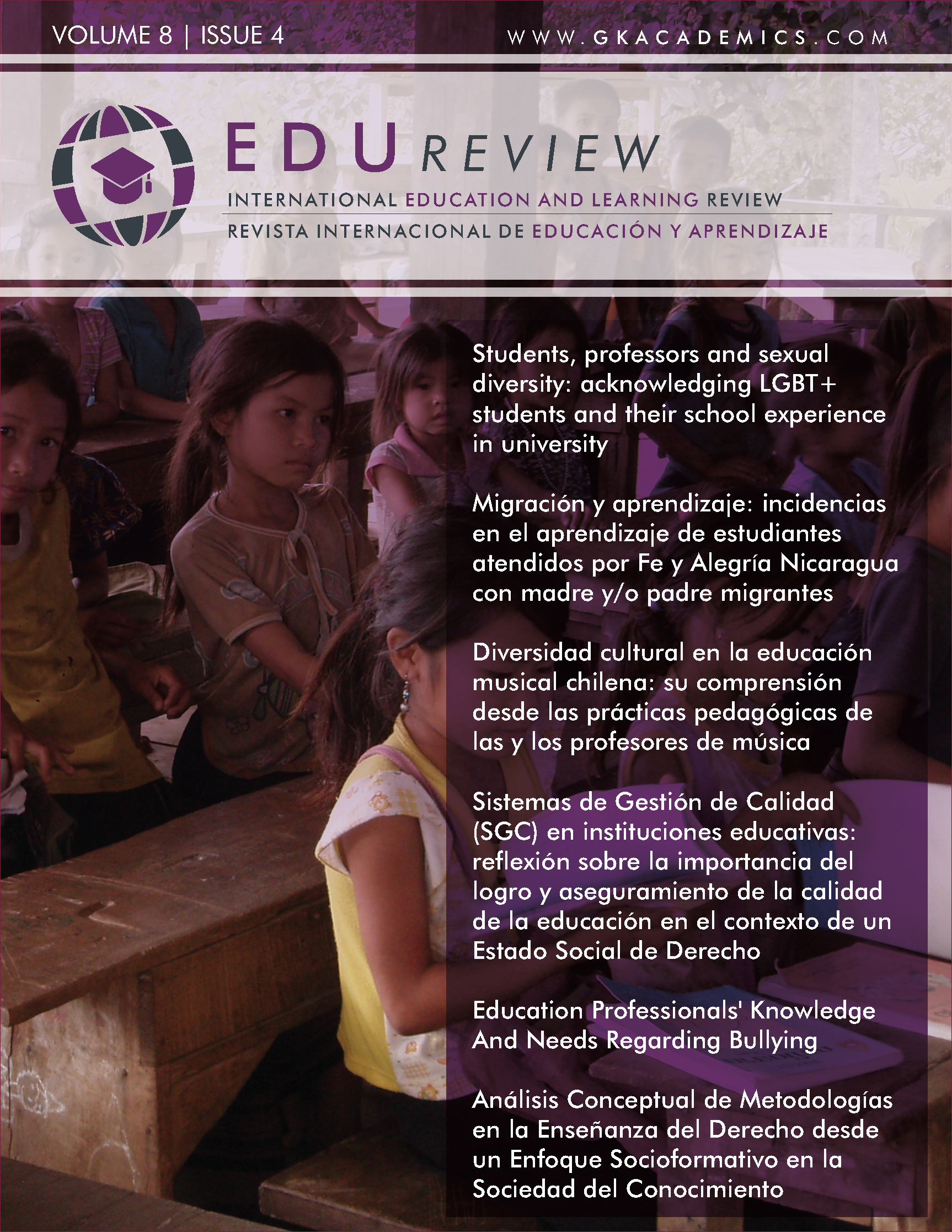Education Professionals' Knowledge And Needs Regarding Bullying
DOI:
https://doi.org/10.37467/gka-revedu.v8.2665Palabras clave:
Bullying, Self-efficacy, Bullying intervention, Teacher educationResumen
The purpose of this study was to analyze teachers' and other education professionals' needs and knowledge when dealing with bullying situations. Data collection was carried out in two different sessions of a bullying prevention one-day symposium at a four-year state university. The participants were 53 educational professionals from several elementary and middle schools. Qualitative analysis of session artifacts revealed that participants had a basic understanding of bullying; however, they doubt its definition and how to identify when it occurs. Participants in the case study were interested in being change agents when it comes to addressing bullying problems. However, they lacked self-confidence and access to appropriate resources to overcome their fears and diminished self- efficacy for proper intervention.
Citas
Álvarez-García, D., Rodríguez, C., González-Castro, P., Núñez, J. C. & Álvarez, L. (2010). La formación de los futuros docentes frente a la violencia escolar. Revista de Psicodidáctica, 15(1), 35–56.
Bandura, A. (1977). Self-efficacy: toward a unifying theory of behavioral change. Psychological Review, 84(2), 191–215. DOI: https://doi.org/10.1037/0033-295X.84.2.191
Byers, D.L., Caltabiano, N.J. & Caltabiano, M.L. (2011). Teachers’ attitudes towardsovert and covert bullying, and perceived efficacy to intervene. Australian Journal ofTeacher Education, 36(11), 105–119. DOI: https://doi.org/10.14221/ajte.2011v36n11.1
Blaya, C., Derarbieux, E. & Lucas Molina, B. (2007). La violencia hacia las mujeres y hacia otras personas percibidas como distintas a la norma dominante: el caso de los centros educativos. Revista de Educación, (342), 61–83.
Bradshaw, C. P., Waasdorp, T. E., O' Brennan, L. M. & Gulemetova, M. (2013). Teachers' and Education Support Professionals' Perspectives on Bullying and Prevention: Findings from a National Education Association Study. School Psychology Review, 42(3), 280–297. DOI: https://doi.org/10.1080/02796015.2013.12087474
Cajigas de Segredo, N., Khan, E., Luzardo, M., Najson, S. & Zamalvide, G. (2004) Escala de Agresión entre Pares para Adolescentes y Principales Resultados. Bullying Scale for Adolescents and Main Results. Acción Psicológica, 3 (3), 173-186. DOI: https://doi.org/10.5944/ap.3.3.511
Díaz-Aguado, M. J. (2006). El acoso escolar y la prevención de la violencia en la familia. Madrid: Consejería de Familia y Asuntos Sociales.
Eden, S., Heiman, T. & Olenik-Shemesh, D. (2013). Teachers' perceptions, beliefs and concerns about cyberbullying. British Journal of Educational Technology, 44(6), 1036–1052. DOI: https://doi.org/10.1111/j.1467-8535.2012.01363.x
Eslea, M. and Rees, J. (2001). At what age are children most likely to be bullied at school? Aggressive Behavior, 27: 419-429. https://doi.org/10.1002/ab.1027 DOI: https://doi.org/10.1002/ab.1027
Gaines, J. (2016). Finland is really good at stopping bullying. Here's how they're doing it. Retrieved from http://www.upworthy.com/finland-is-really-good-at-stopping-bullying-heres-how-theyre-doing-it
Gelo, O., Braakmann, D. & Benetka, G. (2008). Quantitative and qualitative research: Beyond the debate. Integrative Psychological and Behavioral Science, 42(3), 266–290. https://doi.org/10.1007/s12124-008-9078-3 DOI: https://doi.org/10.1007/s12124-008-9078-3
Gladden, R. M., Vivolo-Kantor, A. M., Hamburger, M. E. & Lumpkin, C. D. (2014). Bullying surveillance among youths: Uniform definitions for public health and recommended data elements, Version 1.0. Atlanta, GA; National Center for Injury Prevention and Control, Centers for Disease Control and Prevention, and U. S. Department of Education.
Idaho Youth Risk Behavior Survey, 2017. Summary Report. (2017). Retrieved from http://search.proquest.com/docview/62497910?accountid=14695
Kärnä, A., Voeten, M., Little, T. D., Poskiparta, E., Kaljonen, A. & Salmivalli, C. (2011). A Large-Scale Evaluation of the KiVa Antibullying Program: Grades 4-6. Child Development, 82(1), 311–330. https://doi.org/10.1111/j.l467-8624.2010.01557.x DOI: https://doi.org/10.1111/j.1467-8624.2010.01557.x
KiVa Anti-Bullying Program. (2016). KiVa International. Retrieved January 9, 2018, from http://www.kivaprogram.net/
Lester, L., Waters, S., Pearce, N., Spears, B., & Falconer, S. (2018). Pre-service teachers: Knowledge, Attitudes, and their Perceived Skills in Addressing Student Bullying. Australian Journal of Teacher Education, 43(8), 30-45. DOI: https://doi.org/10.14221/ajte.2018v43n8.3
Nixon, C. L. (2014). Current perspectives: The impact of cyberbullying on adolescent health. Adolescent Health, Medicine and Therapeutics, 5, 143–158. doi:https://doi.org/10.2147/AHMT.S36456 DOI: https://doi.org/10.2147/AHMT.S36456
Olweus, D. (1994). Bullying at school: Long-term outcomes for the victims and an effective school-based intervention program. In R. Huesmann (Ed.), Aggressive behavior: Current perspectives (pp. 97–130). NewYork: Plenum Press. DOI: https://doi.org/10.1007/978-1-4757-9116-7_5
Olweus, D. (2013). School Bullying: Development and Some Important Challenges. Annual Review of Clinical Psychology, 9(1), 751–780. https://doi.org/10.1146/annurev-clinpsy-050212-185516 DOI: https://doi.org/10.1146/annurev-clinpsy-050212-185516
Rigby, K., & Bagshaw, D. (2003). Prospects of adolescent students collaborating with teachers in addressing issues of bullying and conflict in schools. Educational Psychology, 23(5), 535–546. https://doi.org/10.1080/0144341032000123787 DOI: https://doi.org/10.1080/0144341032000123787
Rigby, K., & Barnes, A. (2002). Victimized Student's Dilemma To Tell or Not To Tell. Youth Studies Australia, 21(3), 33–36.
Rigby, K., & Johnson, K. (2016). The Prevalence and Effectiveness of Anti-Bullying Strategies Employed in Australian Schools. Adelaide. Retrieved from www.kenrigby.net/School-Action
Smith PK, del Barrio C, & Tokunaga R. (2012) Definitions of bullying and cyberbullying: How useful are the terms? In Principles of Cyberbullying Research: Definition, Measures, and Methods, ed. S Bauman, D Cross, J Walker, pp. 29–40. Philadelphia, PA: Routledge
Thomas, H. J., Connor, J. P., & Scott, J. G. (2014). Integrating Traditional Bullying and Cyberbullying: Challenges of Definition and Measurement in Adolescents – a Review. Educational Psychology Review, 27(1), 135–152. https://doi.org/10.1007/s10648-014-9261-7 DOI: https://doi.org/10.1007/s10648-014-9261-7
Yoon, J. S. (2004). Predicting teacher interventions in bullying situations. Education and Treatment of Children, 27(1), 37–45. https://bit.ly/2GqblZj
Descargas
Publicado
Cómo citar
Número
Sección
Licencia
Aquellos autores/as que publiquen en esta revista, aceptan los términos siguientes:
- Los autores/as conservarán los derechos morales sobre la obra y cederán a la revista los derechos comerciales.











